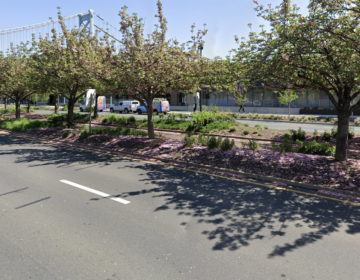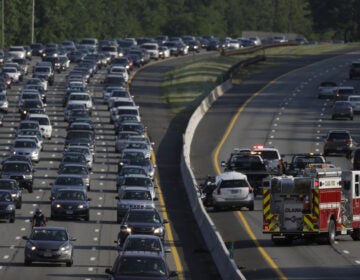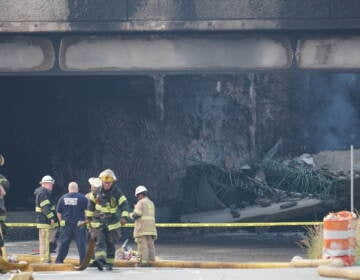By Kellie Patrick
For PlanPhilly
Meredith O’Donnell, her husband and two sons used to do a lot of working and playing in their Mifflin Street basement. Then in August 2004, the first flood came. And at least once each year since, a foot or more water has found its way in – sometimes bringing raw sewage with it.
O’Donnell and other owners of flooding, Delaware River-ward homes say such problems did not exist until big box stores, restaurants, and other developments sprung up on Columbus Boulevard. They do not want waterfront casinos sited there because they believe large buildings with vast parking lots will exacerbate the situation.
“Adding a casino to the mix is going to be a nightmare,” O’Donnell said.
“Before there is any development of any kind, these problems should be fixed,” said McKeen Street resident Nancy Murawski, whose husband rolls up the basement rug and gets the furniture up off the floor each spring.
Major flooding is occurring in Old Kensington, Pennsport and other riverward neighborhoods in South Philadelphia, Northern Liberties and Washington Square West, said Joanne Dahme, watersheds program manager for the Philadelphia Water Department The issue has become so big in Pennsport that the neighborhood association sponsored a symposium on the topic earlier this year.
www.planphilly.com/node/805.
Dahme and Howard Neukrug, office of watersheds director, agree with residents that the flooding has become worse since 2004, but they attribute that to a change in the type of storms the city has experienced, not development. They say the water department is working on both short- and long-term solutions to a very complex problem, the origins of which can be traced back to Colonial Philadelphia.
Much of the city’s 3,000 miles of sewer pipe are old – some of it dates back to the 1880s.
Large portions of today’s system were created by simply piping and burying the open, roadside channels that carried waste and water away from homes and directly into the river. It wasn’t until the 1950s that the city laid pipes to intercept what was going into the river and divert it to the three wastewater treatment plants in Bridesburg, near the airport, and beneath the Walt Whitman Bridge.
Now, hard rains bring flooding troubles.
The biggest sewer pipes are 25 feet in diameter. That’s plenty of space for sewage alone, Neukrug said.“When it’s not raining, if you went down in that 25-foot pipe, you’d see, at most, a foot of water,” he said.
But in about 60 percent of the city – the older neighborhoods – the pipes have to carry more than just sewage. They also have to carry water that pours off of roads, rooftops, parking lots, and other non-porous surfaces that prevent it from being absorbed into the ground. The same is true in older cities everywhere.
This means that in heavy rains, the pipes fill up. With no more room, some of the water and sewage never make it to the treatment plants. Some once again flows directly into the river – and sometimes, into homes.
When the pipe in the street reaches capacity, “the lateral (line) that connects the main pipe to the house acts as a relief valve,” Dahme said. “Water needs to go somewhere. It finds the path of least resistance.” Water and sewage come into the basement through drains and fixtures, she said.
If there are no fixtures in the basement, the laterals back up through the curb trap at the sidewalk, she said. When water enters a basement that does not have fixtures – through walls, windows or floors, for example – it is usually not a sewer issue, but a ground saturation issue.
Anyone who has water in their basement can call the department at 215-685-6300. Someone will help determine the source of the incoming water and whether a back-up valve is needed. If the situation is due to something other than a sewer situation, advice will be given about what can be done or who could be contacted.
The Water Department received about 60 calls from people with water in their basements during and after this week’s deluge, Dahme said, but in most cases, it seems to have seeped in through old, porous basement walls because the ground is saturated, or had come in through ground-level windows. “Most likely it doesn’t have anything to do with the sewer system,” she said. “We had five inches of rain over 24 hours. The system can absorb that.” The storms that cause problems are those that drop that amount of water in a few short hours, she said.
The heavy rains in August of 2004 were one such event, Dahme said. And there have been extreme storms each year since. But residents, who have seen the water pouring off of the big box stores’ parking lots, are convinced they are a factor.
“My father-in-law has lived on McKeen Street for 34 or 35 years,” Murawski said. “He has never seen flooding like we’ve had. There’s Lowes, Target, Shopright – always something – Linens and Things, restaurants. Once they came, everyone started seeing problems.”
This is why she and other residents are convinced that more development will only make things worse. Dahme and Howard Neukrug, the office of watersheds director, “feel there is a lot more to it than that.”
“Is new development causing problems? No,” Dahme said. “They live in neighborhoods that have been built-out for 100 years. The land has been impervious for all that time. Since 2004, we’ve had rain events with two- to three-inches in 15 minutes.” “No sewer we could put under the ground would be large enough to take the kind of flow that is coming through.”
Neukrug said computer models show that the Columbus Boulevard developments did not add to the problem – the runoff they put into the system enters at a point that does not impact the neighborhoods that are flooding. But Neukrug knows residents’ intuition tells them differently. “It goes against my intuition, that increasing shopping malls and impervious cover does not affect the capacity,” he said. “Maybe we should be looking forward to making some changes on those sites,” he added.
Nevertheless, he does not think new development will make things worse. “Any new development will help solve our problem,” he said. That is because a city ordinance that went into effect in 2006 requires any project that will disturb more than 15,000 square feet to keep the first inch of rainfall from going into the sewer system.
The water can go underground through natural surfaces or newer kinds of pavement that allow water to seep in. Or, it can be captured in an underground container, and then slowly released after the storm is over. “There is very little green field left, it is all pavement,” Neukrug said. “Whatever is happening at the site now, chances are it is not capturing the first one-inch from every storm.” This provision would apply to the casino projects.
The Columbus Boulevard development occurred before this ordinance was passed, but Neukrug hopes those businesses and others will be retroactively compelled to deal with runoff issues. Neukrug said he hopes city leaders will be persuaded to allow the water department to use a new rate structure that would charge landowners based on the amount of runoff water their property puts into sewer system. So, the more rainwater landowners keep from running into the sewer system, the less their water bills would be.
He would like to see this in place within the next year. It would most likely require city council’s nod, but that might not be the biggest hurdle: the logistics of determining how to measure runoff are quite complicated.
About half-a-dozen staffers are now studying detailed maps of every square foot of land in the city, determining the total area of each parcel and the portion that is impervious. “We’re very optimistic about it,” he said. “It is a very important tool. For private land, there is very little else we’ve thought of to produce an incentive.”
Neukrug’s department is already working with public entities to reduce runoff. The Mill Creek Park basketball court, at 48th and Brown streets in West Philadelphia, now has a special infiltration bed beneath it that takes water from the street and parking lot and stores it underneath the court. It drains slowly into the system. Through a partnership with the city recreation department, it is hoped that every court will be modified this way over the next 20 years.
“It’s a whole change in how Philadelphia looks at its water system,” Neukrug said. “It’s very much a 21st Century green approach, versus a 20th Century infrastructure-based approach.”
But to solve the problems, the city must both reduce the amount of water entering the system and increase the capacity of the system, Neukrug said. And that’s where the infrastructure improvements come in.
“We are looking at enlarging sewers in specific areas,” Dahme said. This is a major endeavor that will conservatively cost $200 million over the next ten years, she said.
At Washington Square West, a new stormwater-only pipe will be laid under Pine Street, parallel to the existing sewer, with work beginning within the year.
Other areas are still being studied, but Dahme hopes to have a list of projects by late summer or early fall. Even so, work will likely not begin for about five years, she said. “Once we come up with a solution, we have to design it, put it out to bid, and then begin construction. It takes years.”
One South Philly possibility is the installation of underground storage tanks beneath Marconi Plaza. Similarly to those beneath the basketball courts, they would hold water and release it gradually when there is room within the system.
Joseph A. Feola, director of the state Department of Environmental Protection’s Southeast Regional Office, thinks the city should ask casinos to be “good neighbors” and voluntarily contribute money to increase sewer capacity or curb runoff.
At the Pennsport meeting, he suggested the casinos should be forced to send their sewage directly to the treatment plant so it does not take up any space in the system. But since then, he’s changed his mind, because he thinks it would be wasteful to bury a separate line for a casino when the existing lines need to be enlarged.
Still, he said, “No way should the casino be allowed to put storm water into that system. The casino should be made to separate their flow, with only sewage going into that line. The stormwaters should go directly to the river.”
Dahme said the department is also exploring ways that individual homeowners can be part of the solution. Currently, city law requires roof downspouts to lead into the sewer lines, but under a pilot program, some residents have diverted theirs into rain barrels or large planters.
Details of this approach and other hints for homeowners can be found in the
brochure in pdf form attached below.
The bottom line for homeowners is that while the water department is working on long-term solutions, they will not have dry basements immediately. “This is being addressed today, and improvement will be seen incrementally, more and more over the next 20 years,” Neukrug said. “When specifically (a homeowner) will stop seeing a problem in their basement is too difficult to model,” he said. But they will see improvement.
The water department is working on a quicker, stop-gap measure, however. Dahme said there is $3 million within the 2008 budget – which starts July 1 – to put one-way valves on the pipes of homeowners who have back-up problems. The total 2008 operating budget is about $400 million, including money for the water revenue bureau, the department’s billing agency.
“Normally, as a city agency, we are not allowed to go into a private property and make improvements. But we can justify this because it is a public health concern. We need to protect them,” she said. By the end of June, the valves will be in place in 17 homes that are part of a pilot program, which will be used to determine the per-property cost. Dahme said she is hoping to get to a few hundred homes this year, with the goal of putting these valves in all homes that have problems.
O’Donnell said her family bought a valve that has failed numerous times. Dahme said that if properly installed, these valves will not fail, so long as they are maintained and cleaned out regularly.
The water department also recommends that residents with these valves do not wash clothes, flush their toilets, or otherwise use the system when the system is overwhelmed – a situation that usually lasts from 15 to 30 minutes. The department is looking for some sort of audible or visual signal that will indicate when the one-way valve has been activated, she said.
Dahme’s staff is trying to identify the specific homes that are having trouble and get details on what they have experienced. So far, they have received 750 flood questionnaires – but looking at the neighborhood maps, there could be 1,000 or even 5,000 homes affected, she said. “If they are having flooding, we need to know,” she said. “You would think we would get a call, but we haven’t, and it’s hard for us to guess.”
Dahme said some residents fear that reporting flooding at their homes will reduce property values. Some residents just seem leery of contacting city agencies. At the Pennsport meeting, some residents stood talking to each other in the back of the room about how they did not want city employees in their homes because they had jerry-rigged their own solutions to the water problems.
One river-ward resident interviewed for this story would not allow his name to be used for fear that someone from the city would shut him off unless he made expensive repairs he said he cannot now afford.
When told about the water department’s plans, O’Donnell and Murawski were both pleased that action was being taken, but they remained concerned about their homes and families – especially since a complete fix could be decades off. Last summer “when we drained the water out, the mud was so disgusting. It was inches and inches thick,” O’Donnell said. “That scares me. Where is that coming from? Is it part of my foundation?”
Murawski has a crack in the cement of her basement floor. But one of her biggest concerns is the possibility of mold. “Once it floods, when the water goes away, I go down there with bleach and water and clean it,” she said. “This summer, we will have a mold specialist come out and make sure there is nothing down there.”
Kellie Patrick is a freelance writer with a keen interest in the landscapes, plants and animals of Pennsylvania. A former newspaper reporter who worked for The Philadelphia Inquirer and other papers in Florida and Upstate New York, she lives near Philadelphia with her husband, dog and cat.







